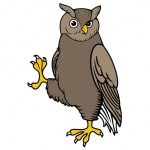Owl: Difference between revisions
From Cunnan
Jump to navigationJump to search
mNo edit summary |
(+image) |
||
| (One intermediate revision by one other user not shown) | |||
| Line 1: | Line 1: | ||
[[Image:owl.jpg|right|150px]] |
|||
The '''owl''' is a nocturnal [[bird]] of prey, known for its silent flight, distinctive "whooo" call, and large, front-set eyes. |
The '''owl''' is a nocturnal [[bird]] of prey, known for its silent flight, distinctive "whooo" call, and large, front-set eyes. |
||
| Line 16: | Line 17: | ||
*http://bestiary.ca/beasts/beast245.htm |
*http://bestiary.ca/beasts/beast245.htm |
||
*http://www.abdn.ac.uk/bestiary/comment/35vbirdf.hti |
*http://www.abdn.ac.uk/bestiary/comment/35vbirdf.hti |
||
[[category:animal]] |
|||
Latest revision as of 12:15, 1 January 2008
The owl is a nocturnal bird of prey, known for its silent flight, distinctive "whooo" call, and large, front-set eyes.
In medieval bestiaries and literature, the owl is often given an unkind treatment, associated with darkness, ruins, and graves.
From Chaucer, The Squire's Tale:
- In which were painted all these false fowls,
- As be these tidifes, tercelets, and owls;
Owls get a more fair treatment in later period. From a 17th century drinking song that is also a popular SCA madrigal:
- Of all the birds that ever I see,
- The owl is the fairest in her degree.
- For all the day long she sits in a tree,
- And when the night comes away flies she.
